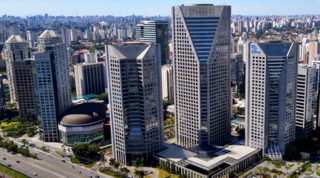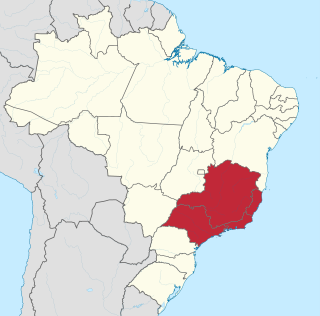
The economy of Brazil is historically the largest in Latin America and the Southern Hemisphere in nominal terms. The Brazilian economy is the third largest in the Americas. The economy is a middle income developing mixed economy. In 2022, according to International Monetary Fund (IMF), Brazil has the 10th largest gross domestic product (GDP) in the world and has the 8th largest purchasing power parity in the world.

Paraná is one of the 26 states of Brazil, in the south of the country. It is bordered in the north by São Paulo state, in the east by the Atlantic Ocean, in the south by Santa Catarina state and the province of Misiones, Argentina, and in the west by Mato Grosso do Sul and Paraguay, with the Paraná River as its western boundary. It is subdivided into 399 municipalities, and its capital is the city of Curitiba. Other major cities are Londrina, Maringá, Ponta Grossa, Cascavel, São José dos Pinhais and Foz do Iguaçu. The state is home to 5.4% of the Brazilian population and generates 6.2% of the Brazilian GDP.

São Paulo is one of the 26 states of the Federative Republic of Brazil and is named after Saint Paul of Tarsus. A major industrial complex, the state has 21.9% of the Brazilian population and is responsible for 33.9% of Brazil's GDP. São Paulo also has the second-highest Human Development Index (HDI) and GDP per capita, the fourth-lowest infant mortality rate, the third-highest life expectancy, and the third-lowest rate of illiteracy among the federative units of Brazil. São Paulo alone is wealthier than Argentina, Uruguay, Paraguay, and Bolivia combined. São Paulo is also the world's twenty-eighth-most populous sub-national entity and the most populous sub-national entity in the Americas.

Steel Authority of India Limited (SAIL) is a central public sector undertaking based in New Delhi, India. It is under the ownership of the Ministry of Steel, Government of India with an annual turnover of ₹105,398 crore (US$13 billion) for the fiscal year 2022-23. Incorporated on 24 January 1973, SAIL has 59,350 employees. With an annual production of 18.29 million metric tons, It is the largest government owned steel producer. The hot metal production capacity of the company will further increase and is expected to reach a level of 50 million tonnes per annum by 2025.

The economy of South America comprises approximately 434 million people living in twelve nations and three territories. It encompasses 6 percent of the world's population.

The Southeast Region of Brazil is composed of the states of Espírito Santo, Minas Gerais, Rio de Janeiro and São Paulo. It is the richest region of the country, responsible for approximately 60% of the Brazilian GDP, as São Paulo, Rio de Janeiro, and Minas Gerais are the three richest states of Brazil, the top three Brazilian states in terms of GDP. The Southeast of Brazil also has the highest GDP per capita among all Brazilian regions.

The economy of India has transitioned from a mixed planned economy to a mixed middle-income developing social market economy and largest South Asian economy with notable public sector in strategic sectors. It is the world's fifth-largest economy by nominal GDP and the third-largest by purchasing power parity (PPP). According to the International Monetary Fund (IMF), on a per capita income basis, India ranked 139th by GDP (nominal) and 127th by GDP (PPP). From independence in 1947 until 1991, successive governments followed Soviet model and promoted protectionist economic policies, with extensive Sovietization, state intervention, bureaucrat driven enterprises and economic regulation. This is characterised as dirigism, in the form of the Licence Raj. The end of the Cold War and an acute balance of payments crisis in 1991 led to the adoption of a broad economic liberalisation in India and indicative planning. Since the start of the 21st century, annual average GDP growth has been 6% to 7%. The economy of the Indian subcontinent was the largest in the world for most of recorded history up until the onset of colonialism in early 19th century. India accounts for 7.2% of the global economy in 2022 in PPP terms, and around 3.4% in nominal terms in 2022.

Vale S.A., formerly Companhia Vale do Rio Doce is a Brazilian multinational corporation engaged in metals and mining and one of the largest logistics operators in Brazil. Vale is the largest producer of iron ore and nickel in the world. It also produces manganese, ferroalloys, copper, bauxite, potash, kaolin, and cobalt, currently operating nine hydroelectricity plants, and a large network of railroads, ships, and ports used to transport its products.
Braskem is a Brazilian petrochemical company headquartered in São Paulo. The company is the largest petrochemical company in Latin America and has become a major player in the international petrochemical market.

Companhia Siderúrgica Nacional (CSN) lit. 'National Siderurgy Company' or 'National Steel Company' is the largest fully integrated steel producer in Brazil and one of the largest in Latin America in terms of crude steel production. Its main plant is located in the city of Volta Redonda, in the state of Rio de Janeiro. Its current CEO is Benjamin Steinbruch.

Mining in Iran is still under development, yet the country is one of the most important mineral producers in the world, ranked among 15 major mineral-rich countries, holding some 68 types of minerals, 37 billion tonnes of proven reserves and more than 57 billion tonnes of potential reserves worth $770 billion in 2014. Mineral production contributes only 0.6 percent to the country's GDP. Add other mining-related industries and this figure increases to just four percent (2005). Many factors have contributed to this, namely lack of suitable infrastructure, legal barriers, exploration difficulties, and government control.

The agriculture of Brazil is historically one of the principal bases of Brazil's economy. While its initial focus was on sugarcane, Brazil eventually became the world's largest exporter of coffee, soybeans, beef, and crop-based ethanol.

Brazilian industry has its earliest origin in workshops dating from the beginning of the 19th century. Most of the country's industrial establishments appeared in the Brazilian southeast, and, according to the Commerce, Agriculture, Factories and Navigation Joint, 77 establishments registered between 1808 and 1840 were classified as "factories" or "manufacturers". However, most, about 56 establishments, would be considered workshops by today's standards, directed toward the production of soap and tallow candles, snuff, spinning and weaving, foods, melting of iron and metals, wool and silk, amongst others. They used both slaves and free laborers.

Ternium S.A. is a manufacturer of flat and long steel products with production centers in Argentina, Brazil, Mexico, Guatemala, Colombia, and the United States. It is the leading steel company in Latin America with highly integrated processes to manufacture steel and value-added products. Along with Nippon Steel and Companhia Siderúrgica Nacional, Ternium owns Usiminas of Brazil. The company has an annual production capacity of 12.4 million tons.
Venezuela has the largest conventional oil reserves and the second-largest natural gas reserves in the Western Hemisphere. In addition Venezuela has non-conventional oil deposits approximately equal to the world's reserves of conventional oil. Venezuela is also amongst world leaders in hydroelectric production, supplying a majority of the nation's electrical power through the process.
Hydrocarbons are the leading sector in Algeria's mineral industry, which includes diverse but modest production of metals and industrial minerals. In 2006, helium production in Algeria accounted for about 13% of total world output. Hydrocarbons produced in Algeria accounted for about 2.9% of total world natural gas output and about 2.2% of total world crude oil output in 2006. Algeria held about 21% of total world identified resources of helium, 2.5% of total world natural gas reserves, and about 1% of total world crude oil reserves.

The economy of Argentina is the second-largest national economy in South America, behind Brazil. Argentina is a developing country with a highly literate population, an export-oriented agricultural sector, and a diversified industrial base.
Belo Horizonte, Brazil's sixth largest city, and the capital of Minas Gerais state, has a vibrant, diversified economy. It receives a large number of visitors and exerts a pivotal influence in the country's economy. Both multinational and Brazilian companies, such as Google, Deloitte, Thoughtworks, Localiza, Oi, and Fiat maintain offices or headquarters in the city. The service sector plays a very important role in the economy of Belo Horizonte, being responsible for 85% of the city's gross domestic product (GDP), with industry making up for most of the remaining 15%. Belo Horizonte has a developed industrial sector, being traditionally a hub of the Brazilian siderurgical and metallurgical industries, as the state of Minas Gerais has traditionally been rich in minerals.
Mining in North Korea is important to the country's economy. North Korea is naturally abundant in metals such as magnesite, zinc, tungsten, and iron; with magnesite resources of 6 billion tonnes, particularly in the North and South Hamgyong Province and Chagang Province. However, often these cannot be mined due to the acute shortage of electricity in the country, as well as the lack of proper tools to mine these materials and an antiquated industrial base. Coal, iron ore, limestone, and magnesite deposits are larger than other mineral commodities. Mining joint ventures with other countries include China, Canada, Egypt, and South Korea.
The Companhia Siderúrgica Paulista (Cosipa), which could be translated to the São Paulo Steel Company, also known as Usina José Bonifacio de Andrade e Silva, is a steel company located in locality of Cubatão on the São Paulo (state) coastline in Brazil. It covers 12 million square meters, including a bonded private port and has a capacity to operate 12 million tons / year, and a railway complex with capacity to serve 4 million tons / year. The company has about 5,500 employees, of whom 5,300 work in its Cubatão Mill.













